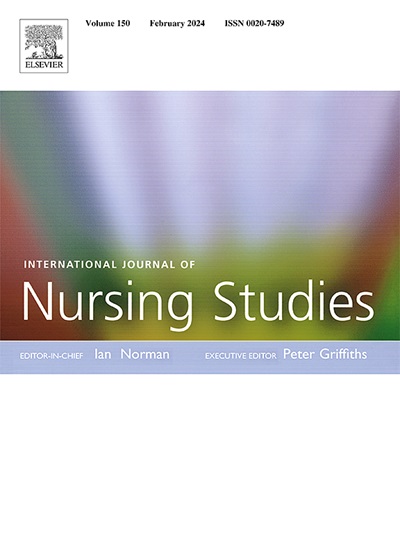Risk prediction models for frailty in older adults: A systematic review and critical appraisal
IF 7.5
1区 医学
Q1 NURSING
引用次数: 0
Abstract
Background
Frailty can lead to increased adverse health outcomes in older adults. Risk prediction models for frailty have benefits in guiding the prevention. Studies have increasingly focused on the development of risk prediction models for frailty in older adults. The quality and clinical applicability of these models remain unknown.
Objectives
To systematically review and critically appraise the current risk prediction models for frailty in older adults.
Methods
PubMed, Embase, CINAHL, and Cochrane Library were searched from inception to June, 2024 to identify published studies focusing on developing or validating risk prediction models for frailty in older adults. Data extraction was independently conducted by two reviewers based on the checklist for Critical Appraisal and Data Extraction for Systematic Reviews of Prediction Modelling Studies. The quality of included models was assessed using the Prediction Model Risk of Bias Assessment Tool.
Results
Of 5421 retrieved studies, 19 studies with 22 risk prediction models for frailty were included. The included models focused on community-dwelling and hospitalized older adults. Logistic regression and machine learning methods were employed to develop risk prediction models. The frequently used predictors were age (77.3 %), cognitive function (31.8 %), self-rated health (27.3 %), sex (22.7 %), activities of daily living (22.7 %), and depression (22.7 %). Internal and external validation were conducted in 17 (77.3 %) and four (18.2 %) models, respectively. Twenty-one (95.5 %) models evaluated model discrimination, with the AUC or c-index ranging from 0.707 to 0.920 in the internal validation and from 0.612 to 0.889 in the external validation. Fifteen (68.2 %) models assessed model calibration using the calibration curve, Hosmer-Lemeshow test, and Brier score and showed good calibration. All risk prediction models had high risk of bias primarily due to problems in the analysis domain and nine (40.9 %) models had high concern regarding applicability.
Conclusions
Current risk prediction models for frailty in older adults demonstrated poor validation and evaluation. Future research should focus on improving current models to aid their implementation and developing and validating new models with rigorous methodology.
PROSPERO registration
CRD42024582883.
老年人虚弱的风险预测模型:系统回顾和批判性评价
背景:在老年人中,虚弱可导致更多的不良健康结果。脆弱的风险预测模型在指导预防方面有好处。研究越来越多地集中在老年人虚弱的风险预测模型的发展上。这些模型的质量和临床适用性仍然未知。目的系统回顾和批判性评价当前老年人衰弱的风险预测模型。方法检索spubmed、Embase、CINAHL和Cochrane图书馆从成立到2024年6月发表的研究,重点开发或验证老年人衰弱风险预测模型。数据提取由两名审稿人根据预测建模研究系统评价的关键评估和数据提取清单独立进行。使用预测模型偏倚风险评估工具评估纳入模型的质量。结果在5421项被检索的研究中,纳入了19项研究和22种衰弱风险预测模型。纳入的模型侧重于社区居住和住院的老年人。采用逻辑回归和机器学习方法建立风险预测模型。常用的预测因素是年龄(77.3%)、认知功能(31.8%)、自我评估健康(27.3%)、性别(22.7%)、日常生活活动(22.7%)和抑郁(22.7%)。分别对17个(77.3%)模型和4个(18.2%)模型进行了内部和外部验证。21个模型(95.5%)评估了模型判别,内部验证的AUC或c-index在0.707 ~ 0.920之间,外部验证的AUC或c-index在0.612 ~ 0.889之间。15个(68.2%)模型采用校正曲线、Hosmer-Lemeshow检验和Brier评分对模型进行了校正,校正效果良好。所有风险预测模型都存在较高的偏倚风险,主要是由于分析领域的问题,9个(40.9%)模型在适用性方面存在较高的关注。结论目前的老年人衰弱风险预测模型验证和评价较差。未来的研究应该集中在改进当前的模型,以帮助他们的实施,并开发和验证新的模型与严格的方法。普洛斯彼罗registrationCRD42024582883。
本文章由计算机程序翻译,如有差异,请以英文原文为准。
求助全文
约1分钟内获得全文
求助全文
来源期刊
CiteScore
15.00
自引率
2.50%
发文量
181
审稿时长
21 days
期刊介绍:
The International Journal of Nursing Studies (IJNS) is a highly respected journal that has been publishing original peer-reviewed articles since 1963. It provides a forum for original research and scholarship about health care delivery, organisation, management, workforce, policy, and research methods relevant to nursing, midwifery, and other health related professions. The journal aims to support evidence informed policy and practice by publishing research, systematic and other scholarly reviews, critical discussion, and commentary of the highest standard. The IJNS is indexed in major databases including PubMed, Medline, Thomson Reuters - Science Citation Index, Scopus, Thomson Reuters - Social Science Citation Index, CINAHL, and the BNI (British Nursing Index).

 求助内容:
求助内容: 应助结果提醒方式:
应助结果提醒方式:


